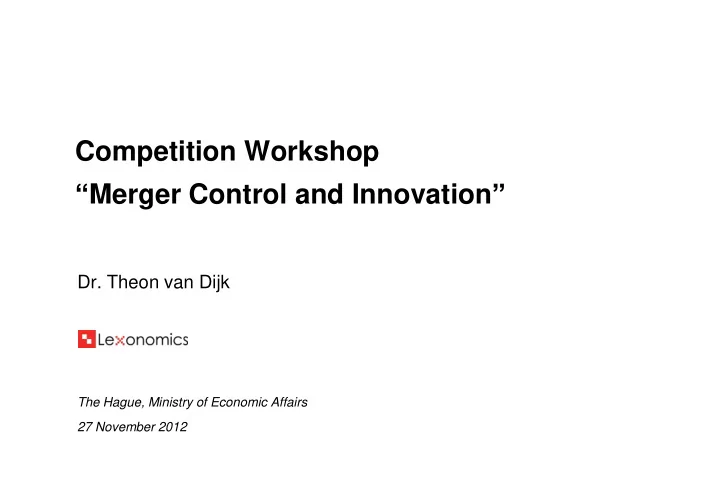

Competition Workshop “ Merger Control and Innovation ” Dr. Theon van Dijk The Hague, Ministry of Economic Affairs 27 November 2012
“ Innovation in EU Merger Control: Walking the Talk ” Professor Reinhilde Veugelers • Larger role for innovation effects in EU merger assessment • Recommendation: mandatory reporting of dynamic efficiencies in Form CO − “ Informational efficiency offence ” − By putting forward a dynamic efficiencies, merging parties “ signal ” problems to competition authority, and hence do not do this 2
Efficiencies to offset anticompetitive merger effects? Dynamic efficiency? No Yes No Static efficiency? Yes 3
Mandatory reporting • Administrative burden • Non high-tech sectors? • “ Informational efficiency offence ” no obstacle in other areas • “ Benefit consumers, be merger-specific and be verifiable ” (EU 2004 horizontal merger guidelines) • Only dynamic efficiencies, not dynamic anticompetitive effects? • Would it make a difference in practice? 4
The current role of innovation effects in merger control • True: dynamic efficiencies hardly play a role (if any) • However: innovations effects are not ignored − Relevant product markets may be defined broader − Dominance and anticompetitive effects are less likely (e.g. more market share fluctuations, more entry) • Mergers in high-tech sectors tend to be less problematic • To some extent “ the talk has been walked ” 5
How to increase the role of innovation effects? • Two opposing approaches: “ Schumpeterian competition ” 1. “ Innovation markets ” 2. (Katz & Shelanski, “ Mergers and Innovation ” , Antitrust Law Journal 2006) 6
“ Schumpeterian competition ” Dynamic efficiency? No Yes No Static efficiency? Yes 7
“ Innovation markets ” • Merger assessment of innovations similar to “ normal ” products/services 1. Define relevant “ innovation markets ” − E.g. “ the research, development and testing of electric motors for cars ” 2. Assess anticompetitive innovation effects of merger − E.g. “ merging parties focus both on electric motors for small cars ” 3. Assess dynamic efficiency effects of merger − E.g. “ R&D efforts likely to increase because R&D mostly complementary ” 8
Between opposing views • Case-by-case approach • Be more permissive for dynamic efficiencies • Adjust the “ verifiability ” condition in EU merger guidelines to be more open for dynamic efficiencies − Current phrasing: “ Efficiencies have to be verifiable such that the Commission can be reasonably certain that the efficiencies are likely to materialise , and be substantial enough to counteract a merger's potential harm to consumers. The more precise and convincing the efficiency claims are, the better the Commission can evaluate the claims. Where reasonably possible, efficiencies and the resulting benefit to consumers should therefore be quantified . When the necessary data are not available to allow for a precise quantitative analysis, it must be possible to foresee a clearly identifiable positive impact on consumers, not a marginal one. In general, the longer the start of the efficiencies is projected into the future, the less probability the Commission may be able to assign to the efficiencies actually being brought about. ” (paragraph 86 of 2004 Horizontal Guidelines) 9
Between opposing views • However: also pay attention to potentially anticompetitive dynamic effects: − Weakening of competition to generate innovations? − Later market introduction of innovations? − Lower budgets for substitute R&D programmes? 10
To conclude 1. Larger role needed for innovation effects in EU merger control 2. Better ways than mandatory reporting to get more attention for dynamic efficiencies (adjust verifiability condition) 3. Also pay attention to dynamic anticompetitive effects 11
More talking needed for the walk … 12
Recommend
More recommend